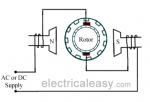180316-1101 EDT
A DC power source I would describe as one that produces only a single polarity output. This does not mean the voltage can not be constantly varying from 0 volts to many other voltages of a single polarity.
However, in this varying voltage case I would rather call it a DC voltage with an AC component.
Sometimes when the variation is not huge the AC component would be called ripple. I could also have a pulsed DC source where the DC voltage is present for only a very small percentage of time. For example, power to a radar transmitter. Like a 1 microsecond pulse every 5 milliseconds. For a target 300 miles away the roundtrip travel time for the transmitted pulse is 2*186,000/300 = 1.24 milliseconds. I believe the pulse rep rate for the Pearl Harbor (1941) radar was 3 milliseconds.
An AC voltage source would be one where the polarity of the source is repetitively changing between + and -. This could be of any waveform.
An AC voltage source might contain a DC component, bad for the input to a transformer. Some phase shift dimmers, probably most by numbers, produce this problem. Ideally you probably want your AC source to have no DC component. You also may want your your AC to be a sine wave rather than some other wiggly waveform.
Lights:
Light produced by heating a material, an incandescent bulb, doesn't care much on how you get heat into the emitting material. The primary consideration is the material thermal time constant compared to the pulse rate of energy input. Ripple of light intensity.
Of secondary importance is bulb lifetime. Possibly shorter on DC.
Gaseous discharge lights to some extent don't care about AC or DC so long as electron emission can occur. However, pulsed DC or AC may require a sufficiently high frequency to avoid flicker. 120 Hz (2 pulses per 60 Hz cycle) is usually high enough.
Basic LED chips are strictly DC. Light is produced only with one direction of current flow. An LED can be driven with AC, but consideration of the LED PIV rating has to be considered. An LED is an approximately constant voltage load, not real constant, but needs to be driven from an approximately constant current source. What may be called an LED light is a considerably different animal than an LED chip.
Motors:
Broadly there are DC, AC-DC, and AC motors.
To get motor rotation there must be one magnetic field pulling or pushing another one.
In some ways a multiphase AC motor is easiest to understand its rotation. With a multiphase motor with fixed in space coils and AC excitation of the coils with phase difference between the coil excitations a magnetic vector can be created that rotates in space. This goes back to the fact that the sum of sine waves of the same frequency and related phase produces a sine wave.
If I have a moderately constant amplitude magnetic vector rotating about an axis in space and I add a PM magnet located about the same axis, then that PM magnet will magnetically couple with the vector and rotate at synchronous speed. Thus, an AC synchronous motor.
You can demonstrate this by putting a PM magnet on one shaft, and a different one on a separate independent shaft.
An AC induction motor works by having a rotor with shorted turns on it. From the rotating magnetic field vector there will be current induced in the shorted rotor coils producing magnet fields that link with the rotating vector. But slip, difference is speed, between the rotating vector and the rotor must exist to induce any current in the rotor coils. Amount of slip increases as load increases because more rotor current is required.
There are wound rotor induction motors so rotor resistance can be changed to change motor characteristics.
An AC synchronous motor has no slip between the rotating vector and the rotor as load is increased. Rather as load increases the lag angle between the rotor shaft and the rotating vector increases.
A true single phase induction or synchronous motor does not have a rotating magnetic vector in space. Rather it has an oscillating, changing amplitude and polarity, single direction in space vector.
This motor must be started in some fashion. Usually some form of a two phase motor, or use a pull rope.
Once started the rotor inertia keeps the rotor rotating, and the pulsating magnetic field kicks the rotor every 1/2 cycle. The same as putting energy into a swing.
A DC motor consists of a fixed magnetic field, either a coil or permanent magnetic, and coils of wire on a rotor. The coils are connected to a commutator, a many pole switch. Current is switched to a coil in synchronization with the rotor position so as to push or pull the rotor. When a particular coil has done its job a different one is switched in. Thus, unidirectional rotation.
A universal motor is a DC motor where the field is AC excited as well as the commutated rotor. So the magnetic fields are always phased to cause rotation in one direction independent of the input AC polarity. In a series motor the armature and field always have the same current and no phase shift between the two.
Possibly more some other time.
.

